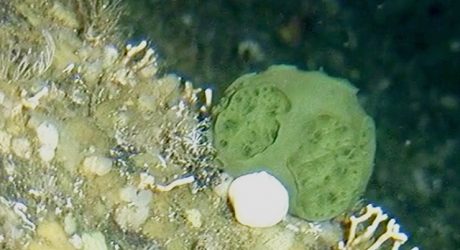A golf ball-size sponge discovered in the deepest, darkest ocean areas off Alaska holds promise in developing new treatments for pancreatic cancer, according to biomedical researchers.
Teams at the Medical University of South Carolina and Henry Ford Cancer Center in Detroit — who specialize in studying chemical samples from the ocean ecosystem — studied a sample of green sponge (Latrunculia austini) discovered by NOAA scientist Bob Stone during a fisheries survey in 2005.
Upon examination, the cancer researchers uncovered molecular compounds effective at selectively targeting and killing tumor cells.
Compared to its dazzling deep-sea coral neighbors, the green Latrunculia austini sponge is pretty drab. Dotted with craters and pitted by deep holes the golf-ball sized sponge is curious-looking rather than beautiful. But green Latrunculia’s unique chemical composition holds a promise much greater than mere beauty.
“You’d never look at this sponge and think this is a miracle sponge, but it could be,” said Stone, a researcher at the National Oceanic and Atmospheric Administration (NOAA) Fisheries’ Alaska Fisheries Science Center.
By the time Stone found the sponge, his groundbreaking research in Alaska had already intrigued leading biomedical researcher Mark Hamann, the Charles and Carol Cooper SmartState Endowed Chair at the Medical University of South Carolina. Hamann has studied marine life to develop drug leads for more than 20 years. While Hamann explores the ocean in search of rare natural compounds, he also constantly monitors publications for other scientists’ discoveries, which led him to Stone.
After the green sponge was discovered, it quickly became a focal point of this global collaboration. Stone and Hamann worked with Michelle Kelly, a world expert on sponges, to name and identify Latrunculia austini.
Hamann and his team determined that the sponge “covers unique and unprecedented chemical space. The structures of the molecules are not related to anything you would find on land or even in tropical shallow-water marine environments.”
Hamann sent samples of the molecules to researcher Fred Valeriote, senior researcher with the Henry Ford Cancer Institute. Scientists there are doing cutting-edge cancer research and grow tumor cells, allowing them to study the cells and test new drug leads in a controlled environment.
Valeriote exposed the pancreatic cancer cell line to a sample from the green sponge extract. The lab test revealed that the green sponge extract had anti-cancer activity, or the ability to kill pancreatic cancer cells.
“On average, less than one in 100 sponge extracts will present the anti-cancer activity that we observed with the green sponge in our lab. It’s a promising initial step forward in developing new treatments for pancreatic cancer,” said Valeriote. “Given the lack of current effective drug treatments available for pancreatic cancer, this study finding offers hope for the future of cancer care.”
He explained that pancreatic and ovarian cancers are generally slow-growing tumors. He said late detection is one reason why these cancers are so deadly, but another factor is that chemotherapy is not effective against slow-growing tumors. As a result, even in its earliest stage, the five-year survival rate for the most common type of pancreatic cancer is about 14 percent, according to the American Cancer Society.
That’s why the green sponge, with its unique discorhabdin compounds, is so exciting to researchers.
“This is absolutely the most active molecule against pancreatic cancer that we have ever seen. Although a significant amount of work remains, this type of activity and selectivity is the key first step in the discovery and drug development process,” Hamann said.
Scientists at the University of Hawaii are working to synthesize the green sponge’s molecules. Synthesizing naturally-derived drugs is normally attempted after a drug proves its effectiveness because the work is challenging and expensive. But because there are hurdles to obtaining the green sponge in nature researchers are working toward synthesizing its molecules now. (NOAA)
Read more: http://www.caribbean360.com/news/discovery-green-deep-sea-sponge-shows-promise-cancer-research#ixzz4qOPqaNha














